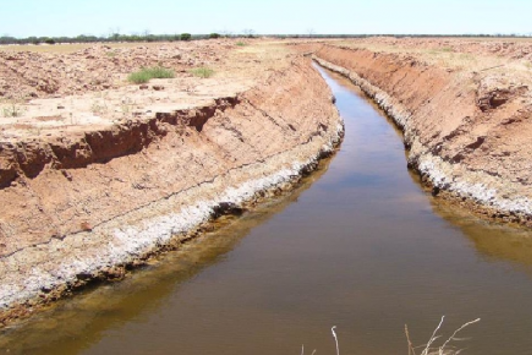The Soil and Land Conservation Act 1945
The department carries out the requirements of the Soil and Land Conservation Act 1945 to prevent land degradation throughout Western Australia (WA).
The drainage of saline land, subsurface groundwater, and discharge onto other land or into other water and waterways, is controlled by the Soil and Land Conservation Regulations 1992.
These regulations require landholders (owner or occupier) who intend to drain or pump water, to notify the Commissioner of Soil and Land Conservation at least 90 days before discharging water.
Drainage notification requirements
Notification allows for the proposed works to be assessed by the Commissioner (or the Commissioner's agent) and gives neighbouring landholders and public authorities the opportunity to comment on the drainage proposal.
Notification is required regardless of the salinity (or freshness) of the discharge water. If the intent of the drainage works is to control salinity by discharging water, notification is required.
Submit notification to the Commissioner on the correct form at least 90 days before discharging any water.
Notification is required for all subsurface drainage for salinity control.
Notification is required for all surface and subsurface drainage in the Peel-Harvey Catchment.
Drainage is generally not required to be notified for most surface water management. More information on surface water management is available on the department's website.
Drainage practice and principles
In this order, good practice by a landowner includes:
- site survey and recording of soil and water salinity (needed to assess success of drainage)
- planning and design at catchment and property level
- notifying neighbours and getting their comments – mandatory
- submitting a Notice of Intent to Drain (NOID) to the Commissioner at least 90 days before construction – mandatory
- having an onsite inspection of the proposed drain and discharge by a Commissioner's officer – mandatory
- on receiving a 'no objection' response from the Commissioner, organising the works (with or without a contractor)
- constructing the drains using sound engineering designs
- monitoring rates of flow and water quality
- monitoring any changes in the surface salinity, and downstream changes (needed to assess success of drainage and unintended results)
- maintenance of the drain and discharge points.
Arising from the Policy framework for inland drainage, the following apply during the Notice of Intent:
- Drainage should be considered within an integrated catchment management framework, as part of the total water cycle, and how the quality and quantity of drainage water is managed.
- Environmental impacts, positive and negative, should be identified and described at a level appropriate to the scale of the drainage proposal. Proposals should demonstrate an overall environmental benefit.
- Public good from the proposal should be identified and be relative to the scale and risk of the proposal.
- Best practice appropriate to the scale and risks of the proposal should be used for planning, design, consultation, construction and management.
- Consultation and participation are expected for stakeholders affected by drainage proposals.
- Costs for design, construction, operation and maintenance shall be identified, allocated and agreed for the life of the drainage.
- Where necessary (depends on scale of the proposal), there should be documentation of governance, financial arrangements, and intentions for detailed design, access, construction, operation, maintenance, monitoring and evaluation, and allocation of liabilities.

